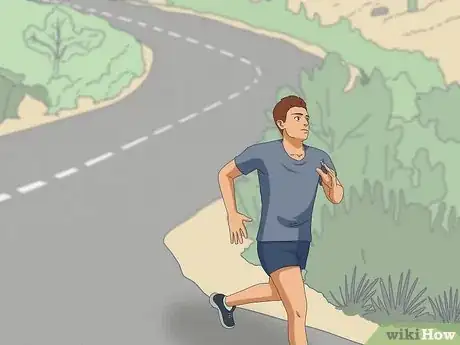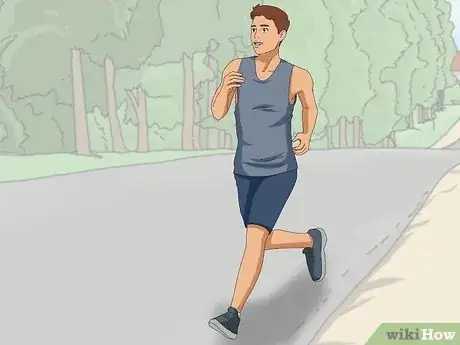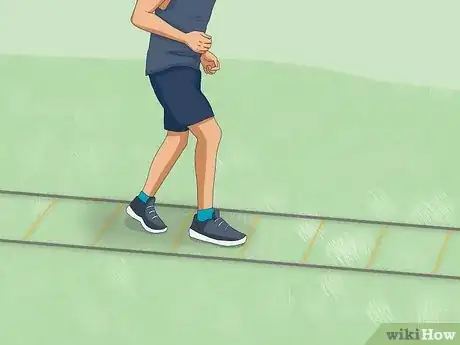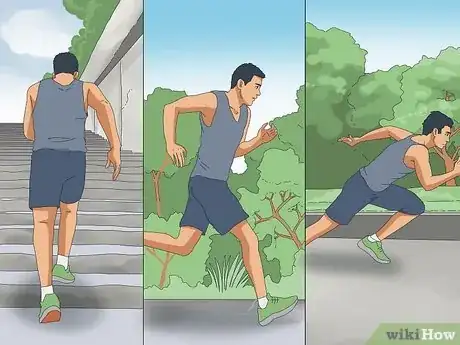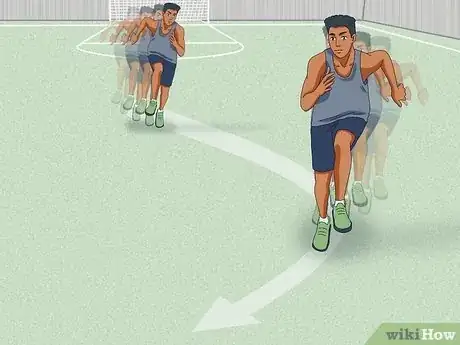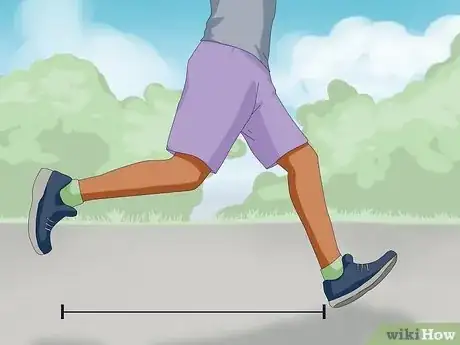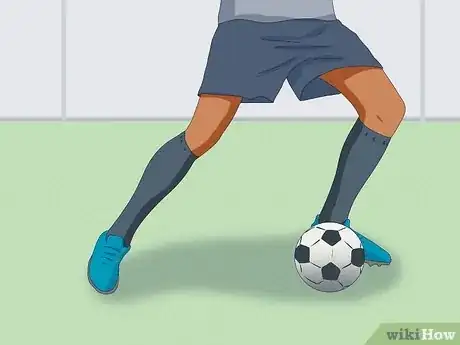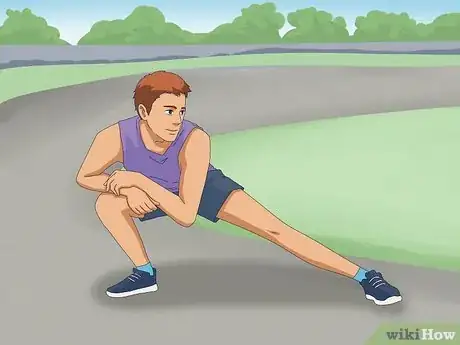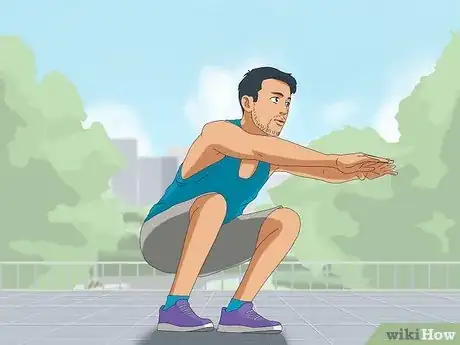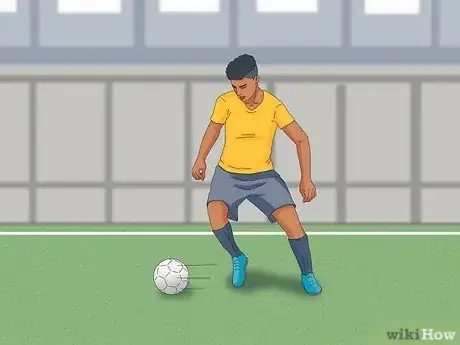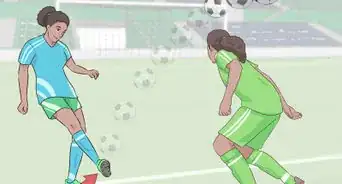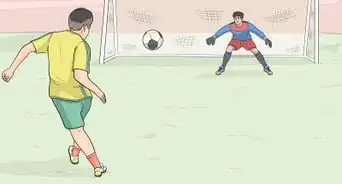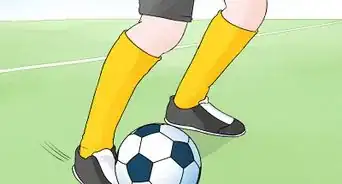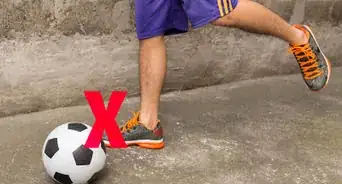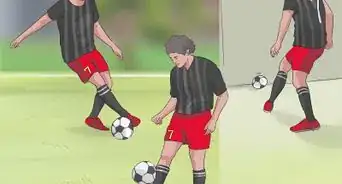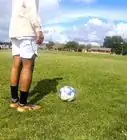This article was co-authored by Misty Benson. Misty Benson is a Soccer Coach and Academic Specialist in Plano, Texas. She has been the head coach of high school soccer teams since 2003 and the Coordinator for US Soccer National Teams since 2013. She has a Master’s Degree in Educational Administration from Texas A&M-Commerce.
wikiHow marks an article as reader-approved once it receives enough positive feedback. This article received 12 testimonials and 100% of readers who voted found it helpful, earning it our reader-approved status.
This article has been viewed 395,599 times.
Soccer (football to readers in most of the world) demands both speed and endurance. You don't need to be Usain Bolt to succeed, but explosive sprints are definitely worth the training. To be successful, you'll also need to improve your mental speed, including your sense of anticipation and your ability to quickly change movements and techniques. Bring your A game to the field by increasing your speed and agility in running, ball control, and reaction time.
Steps
Building Speed
-
1Do sprint drills to raise your maximum speed.[1] Training to reach high speeds within relatively short distances can increase your top speed. Sprint drills are an easy way to accomplish this.[2]
- Run at top speed for 22-33 yards (20-30 meters).
- Make sure that your arm action is smooth and relaxed during the exercise. Keep your arms close to your body.
- Focus on making smooth, even strides.
- Keep your head relaxed and in a natural position.
- Slow jog or walk back to your starting point when finished with the sprint.
- Do 2-4 repetitions of this drill.
-
2Do acceleration drills. The ability to accelerate quickly is critical in soccer, and often more important than a high maximum speed. Acceleration drills will make you build up to and come down from high speeds more efficiently.[3] This type of exercise also helps you work high speeds into other routines. To do a simple acceleration drill:
- Jog for 7 yards (6.4 meters), then accelerate. Begin to decelerate around yard 12 (meter 11). Repeat the sequence, then walk back to your starting point.
Advertisement -
3Use a speed ladder. Training with a speed ladder will increase your speed, lower body agility, balance, and coordination. This horizontal tool requires you to alternate your feet across successive rungs as you run. To improve your speed, train with the ladder while using a stopwatch, and work on improving your best time.
- Speed ladders are available at many athletic supply stores and online.
-
4Try interval training. To use speed effectively on the field, you will have to get used to using bursts of speed interspersed within other movements. To accomplish this, do 30 minutes of interval training. Alternate light jogging (5-10 min) with short bursts of more powerful exercises, such as:
- Sprints
- Running stairs or hills
- Ladder drills
- Using a ball in combination with any of the above
Increasing Agility
-
1Train to improve reaction speed.[4] Being fast on the field isn't just about running speed—it's also about your ability to change your direction, speed, or technique quickly and frequently. To improve your reaction speed, practice while a coach or friend calls (or better, uses a visual signal) for you to change your exercise. Respond as quickly as possible. Try incorporating a combination of exercises like:
- Changing direction quickly when running
- Sprinting on command
- Playing “Red Light Green Light”
-
2Extend your joints. To accelerate, you will have to extend and use your hip, knees, and ankles. When running or doing other exercises, focus on making long, even strides that stretch out. Increasing your stride length and muscle output in this way will boost your speed.
-
3Practice ball exercises. While training to increase your speed at moving across the field, do not neglect your control of the ball. Remember that soccer is primarily a sport where the player's lower body moves in contact with the ground and ball. To be not only fast, but fast and in control of the ball, you must work on your agility.
- Dribble at every opportunity, using all parts of your foot (outside, inside, top, and bottom).
- Do speed dribbling exercises by kicking the ball slightly forward and running after it.
- Practice changing direction quickly while dribbling and doing speed dribbling exercises. You can also do this while attempting to evade another player in order to practice using quick dribbles as a way to beat opponents.
- Do lateral ball drop exercises. Have a coach or partner hold a ball at shoulder height, 5.4 yards (5 meters) away from you. When your coach/partner drops the ball, attempt to reach and control the ball before it bounces a second time.
- Practice cone or flag exercises to increase your speed and agility. Time yourself and aim to beat your time each round.
Setting up a Training Routine
-
1Warm up. Warm up by jogging or jumping rope before beginning a speed training session. Then, do some stretches. This will prepare your mind and body. If you do not properly warm up, you risk injuring yourself.[5]
-
2Alternate between speed training and plyometric and weight lifting exercises. After warming up, choose between speed training and plyometric and weight lifting exercises.[6] [7] Do speed training one day and plyometric exercises or weight lifting the next day. In addition to exercises that aim to improve your time, try doing plyometric (explosive) exercises and weight training, such as:[8] [9]
- Jumps
- Squats
- Burpees
- Bench press
- Lifts
- Leg curls
-
3Take a rest day. Speed training takes a lot out of you. It is very important that you take a day to rest between practice sessions. If you try to train for speed while you are sore or fatigued, you will be unsuccessful and risk injuring yourself.
-
4Focus on technique, then speed. It is no use building up speed when you are doing a technique or exercise wrong. Make sure that you have a fundamental knowledge of and good practice with soccer skills before attempting to increase your speed. Focus on doing things the right way, then on becoming faster at them.
Community Q&A
-
QuestionWill this still work for teens such as myself?
 Community AnswerYes. There are no age restrictions. If you want to be faster, you should train every day running up hills help you even more.
Community AnswerYes. There are no age restrictions. If you want to be faster, you should train every day running up hills help you even more. -
QuestionWhenever I try to sprint faster I will pull or tear a muscle. What should I do to stop that?
 Community AnswerYou should always warm up with a light jog to get your blood flowing to your muscles. Once you warm up for around 10-15 minutes, you should stretch the major muscles groups in your body, mostly your legs (arms if you are a keeper). By stretching and getting your blood flowing you are making your muscles able to react quicker and faster without injury.
Community AnswerYou should always warm up with a light jog to get your blood flowing to your muscles. Once you warm up for around 10-15 minutes, you should stretch the major muscles groups in your body, mostly your legs (arms if you are a keeper). By stretching and getting your blood flowing you are making your muscles able to react quicker and faster without injury. -
QuestionI have a problem when I try to run fast. After I run 100 meters I start to lose control and can't any faster. What is wrong?
 Community AnswerThere could be a couple of things wrong. You need to build up stamina first. Start slow and work up to being faster. You also need to make sure you get enough protein. Drink plenty of water and make sure you get enough sleep. Keep practicing and you will get faster.
Community AnswerThere could be a couple of things wrong. You need to build up stamina first. Start slow and work up to being faster. You also need to make sure you get enough protein. Drink plenty of water and make sure you get enough sleep. Keep practicing and you will get faster.
References
- ↑ http://www.soccer-training-info.com/get_faster.asp
- ↑ https://soccermodo.com/how-to-get-faster-in-soccer/
- ↑ https://www.goplay-sports.com/blog/2021/3/18/how-to-get-faster-in-soccer-an-interview-with-speed-and-strength-coach-melanie-redd
- ↑ http://www.soccer-training-info.com/get_faster.asp
- ↑ https://soccermodo.com/how-to-get-faster-in-soccer/
- ↑ https://www.blazepod.com/blogs/soccer/soccer-speed-drills-8-tips-on-how-to-get-faster-for-soccer
- ↑ http://www.soccer-training-info.com/get_faster.asp
- ↑ http://www.soccer-training-info.com/plyometrics.asp
- ↑ http://www.soccer-training-info.com/weight_lifting.asp
About This Article
To get faster for soccer, try doing sprint drills where you run as fast as you can over short distances, which will help you increase your top speed. In addition to building your speed, work on on improving your reaction time by changing direction quickly as you run. Since you also have to keep control of the ball as you increase speed, train by dribbling the soccer ball around cones or flags while you time yourself. Between training sessions, take a day to rest so you don’t risk injuring yourself. For tips from our Soccer reviewer on how to set up a training routine to build your speed and agility, read on!
